|
magic mountain posted:They probably don't have neutrals at all, it's pretty common for a heater to use the difference between two phases of 120v, aka 208v. I can't say for sure from what you're describing though, it's really weird that it suddenly doesn't work if you hooked it all up how it was before. Maybe digital vs mechanical doesn't like directly connecting the second phase? Try hooking the white line/load up on the second pole? Edit: Yup, that did the trick. Thanks! Novo fucked around with this message at 04:18 on Jan 13, 2016 |
|
|
|

|
| # ? May 9, 2024 22:49 |
|
Novo posted:Edit: Yup, that did the trick. Thanks! Oh jeez, I just realized your old one was probably capable of working single pole and the new one isn't, digital shouldn't have anything to do with it. Either way, you're welcome! Mimesweeper fucked around with this message at 04:45 on Jan 13, 2016 |
|
|
|
Hurray our coffee maker, dishwasher, and outlet in the dining area don't work, but the breaker is closed and other things on it do work. Pulled off the cover on the left-most one and voila, the start of the chain. Or what should be a chain. Contactless tester beeps, multimeter shows me 120VAC hot to neutral on the poles. There is way too much wire in this thing for a single gang outlet. Flip off the breaker and pull the outlet and the hot wire pops off all on its own, spread it out, close the breaker and confirm, then open it again. Looks like when they installed the their-fridge-now-my-dishwasher outlet in a remodel they just "tapped" this outlet. The white romex(?) goes from this outlet "up" (no strain relief or third ground wire), then enters the dishwasher outlet from the bottom (same thing, but I can see the ground wire). Unhooked the hot and tested with continuity to what I believe verify the two black wires I'm seeing match. There is some brown that does not scrape off my with my fingernail on the romex, is that evidence of arcing? Haven't tested the balance of the "original" non-romex wiring since I think I have a smoking gun. Hot wire verification, first noticed the brown stuff on the romex in this picture: 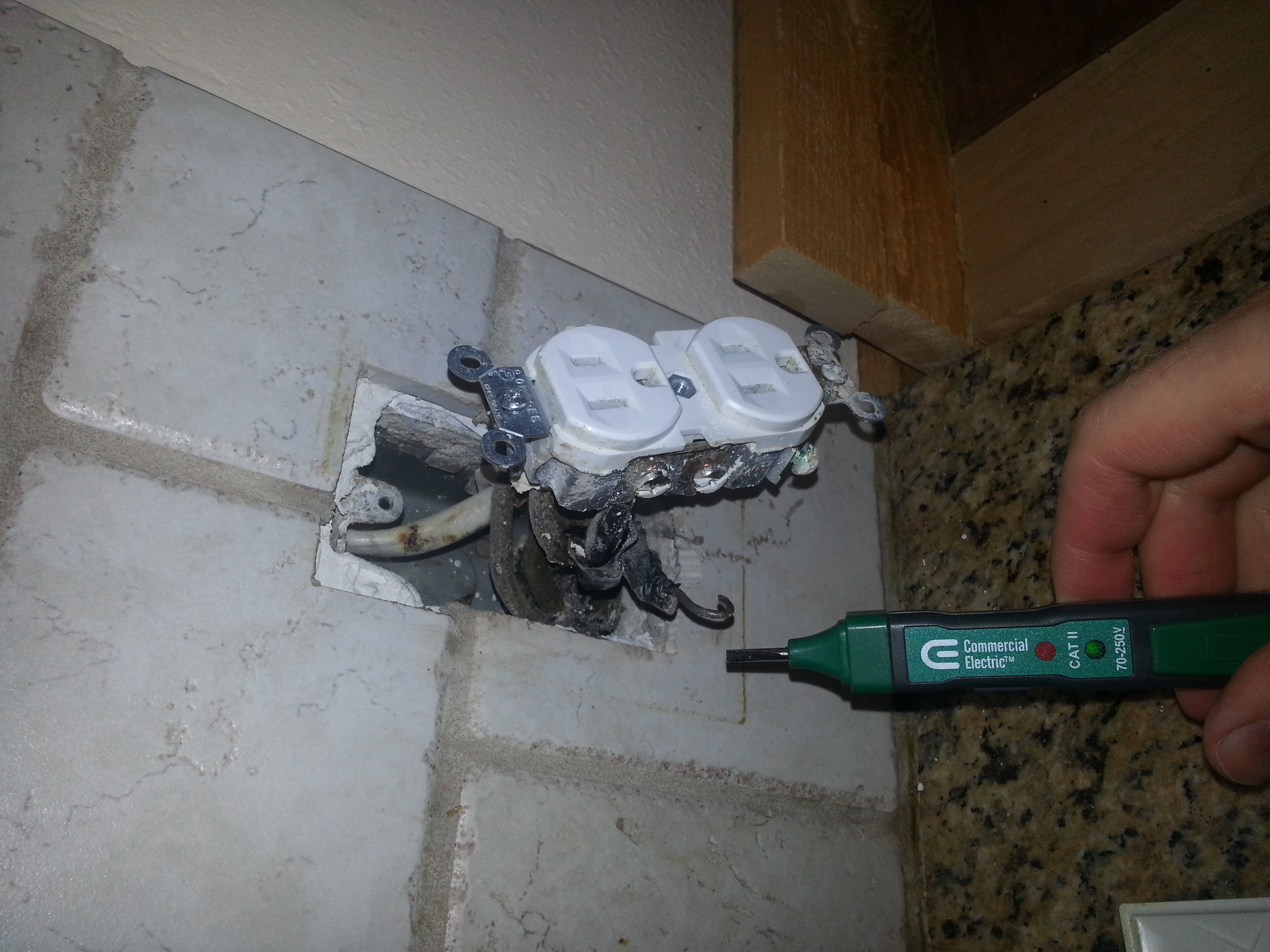 Note the two wires in the bottom of the neutral side: 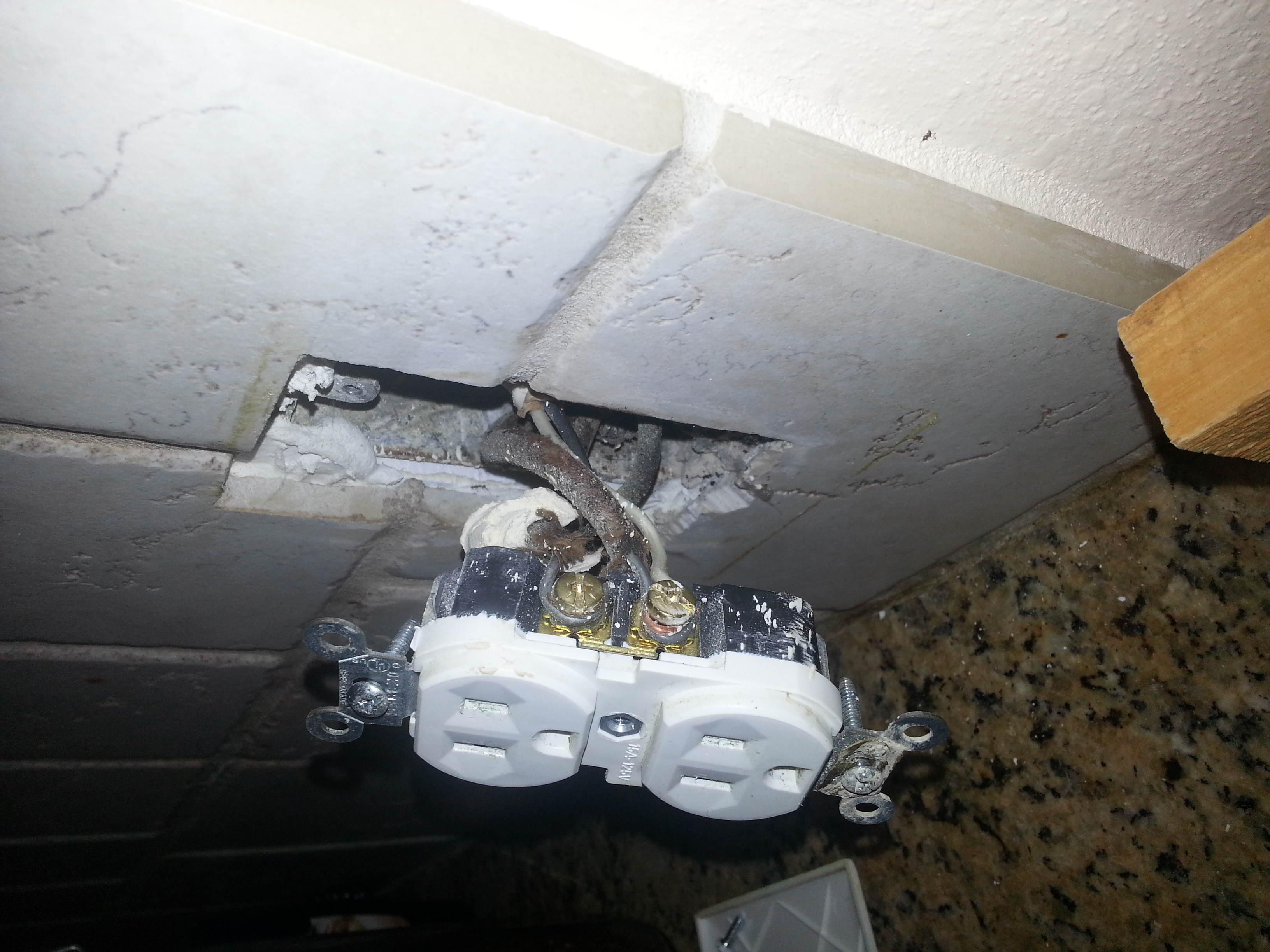 Just a closeup of the "hot side" where you can see the other side of the romex coming in: 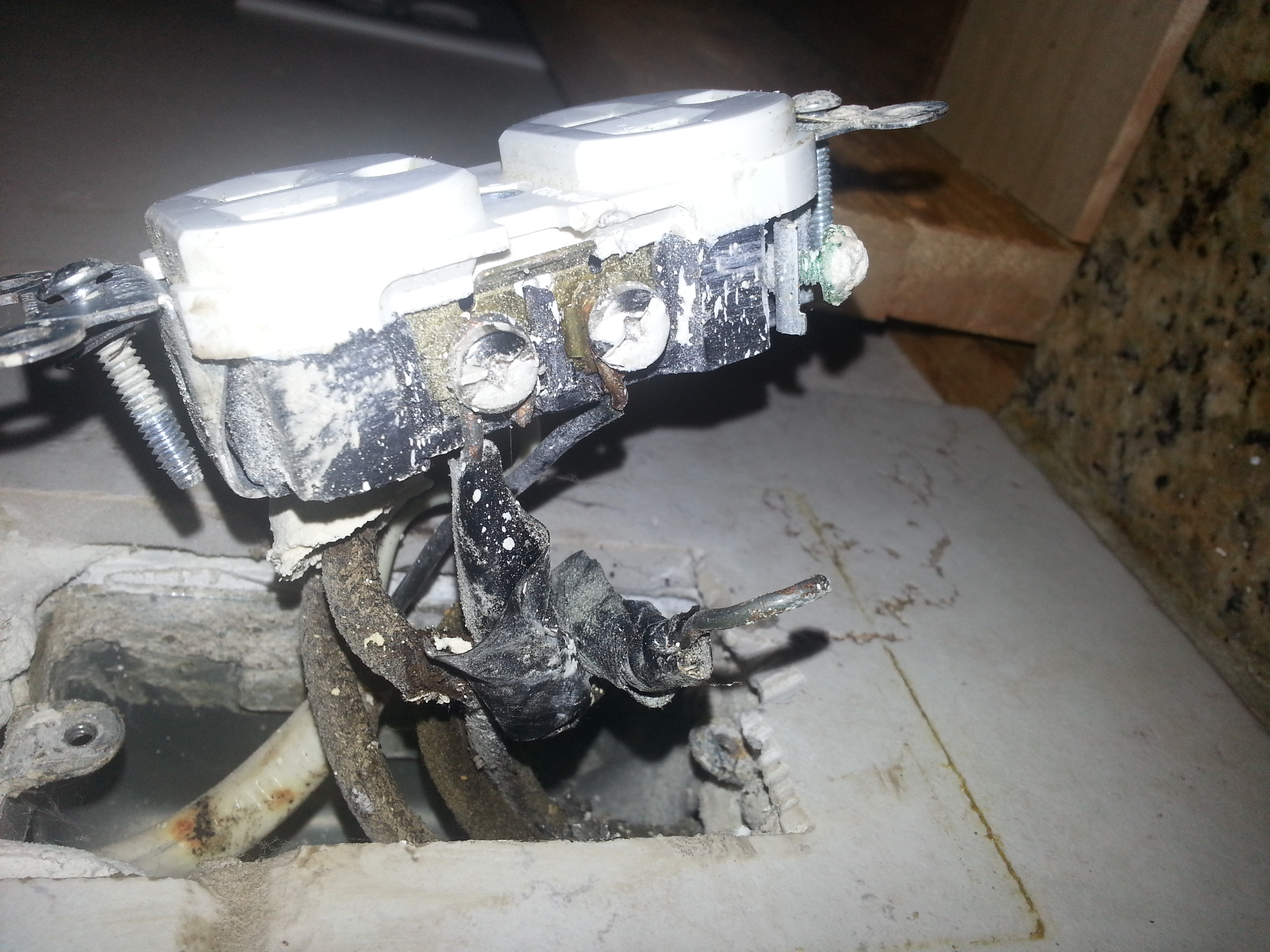 Straight on after fingernail cleaning the discoloration on the romex: 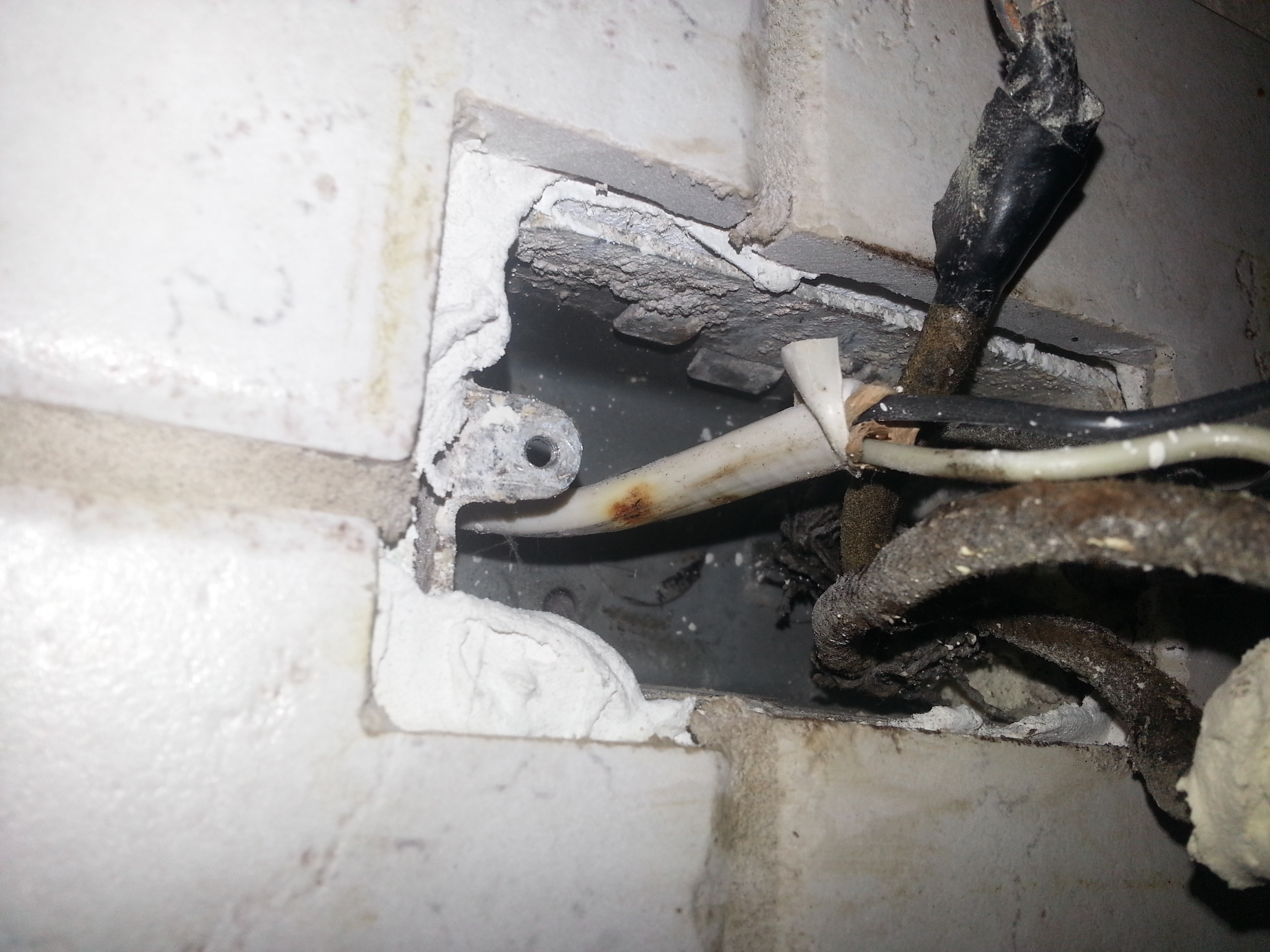 We already have a licensed electrician coming out tomorrow because I originally thought this was rodent damage. I assume this is Not Ok and the correct solution here is to turn this into a proper daisy chain. The dishwasher outlet has nothing on the "load" pins on its outlet. The correctest solution would be to have the electrician pull a dedicated 15A breaker for the dishwasher, plugging Kid Sinister's 120V Glory Hole in our box once and for all. For the latter, would you use a (A|G)FCI breaker?
|
|
|
|
H110Hawk posted:
Unless I'm seeing the colors wrong, arn't the screws on the top picture (what you labeled "neutral side") gold? That would be the hot side, and silver screws are the neutral side. That white on the hot side could be being used as a hot conductor, but was never labeled with black tape properly? Or the other solution is it's just a mess.
|
|
|
|
ninmeister posted:Unless I'm seeing the colors wrong, arn't the screws on the top picture (what you labeled "neutral side") gold? That would be the hot side, and silver screws are the neutral side. That white on the hot side could be being used as a hot conductor, but was never labeled with black tape properly? Or the other solution is it's just a mess. The very first picture is right after I pulled it out and before any untwisting or unscrewing of the terminals. The wire chilling out in the air was "hot" according to the tester and fell off the second the screws came undone which were holding the receptacle in place. That is the only evidence I have of "hot/neutral". The last picture I have untwisted things to get a clearer look at the various wires, so the ground pin is "up." Here is a picture, this is the only terminal I've unscrewed, the balance of them I gave a gentle tightening to make sure they weren't comically loose. The empty silver terminal is where the hot wire and the black romex were screwed on. The other side is gold. 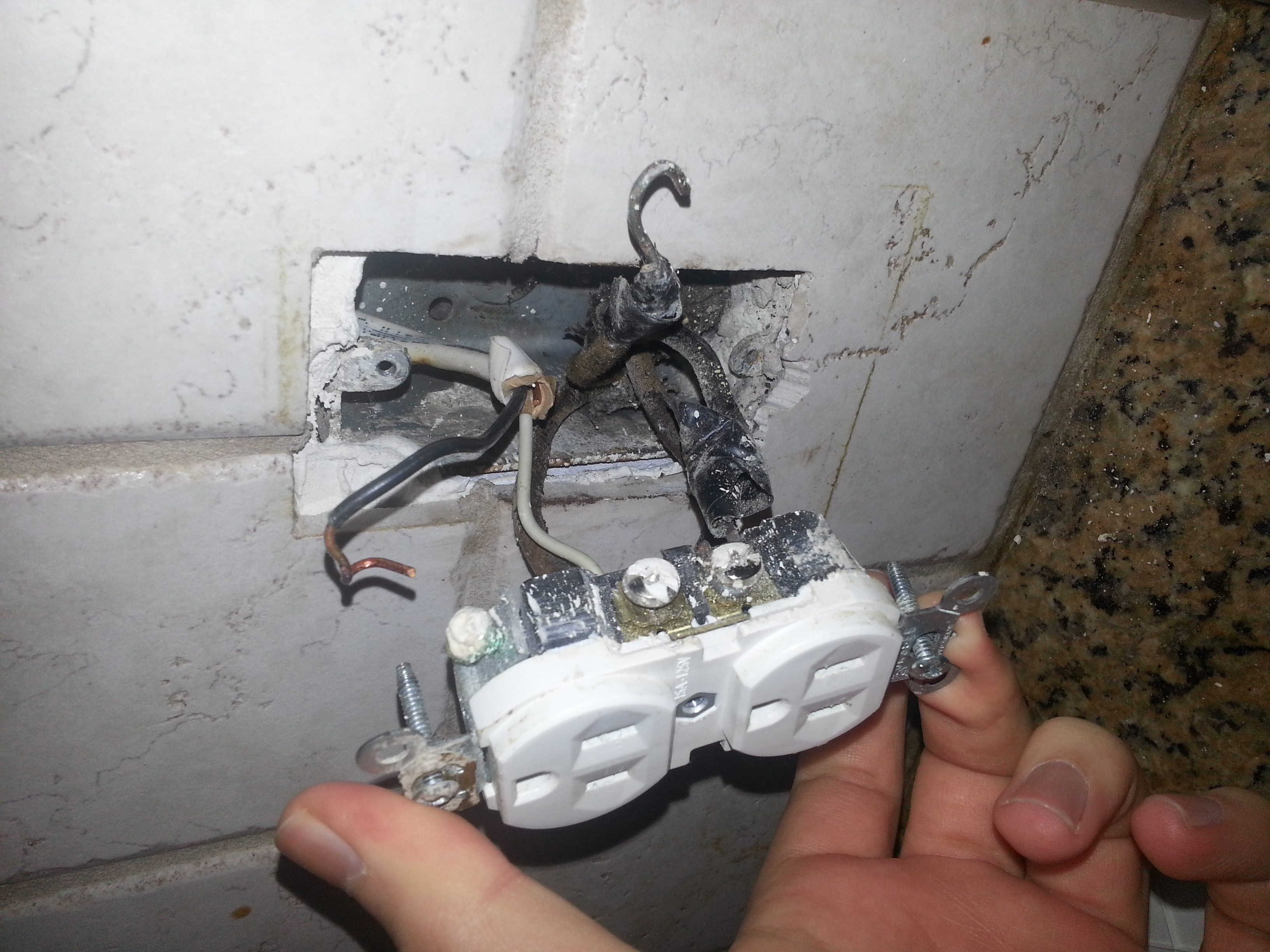
|
|
|
|
Electrician came, pigtailed it and pushed it back in.
|
|
|
|
I own a 1950s era home I intend to sell very soon. While an electrician was around for some minor work prior to listing, he noticed the grounds in the panel are aluminum, which I know to be bad news. Some of the outlets in the original part of the house are ungrounded, and his theory was these were added in the 70s to get grounds to part of the house. He explained the issues with oxidation and thermal expansion and said "you're hosed". Can I get a thread opinion? His advice was let a buyers inspector make a stink, then come to an agreement in price adjustment or remediation. The home is vacant now, with very little electrical load. I lived in the home for 5 years, and was not aware of the potential fire/arcing issue. Anyway selling a home is proving to be as stressful as buying.
|
|
|
|
Mercury Ballistic posted:I own a 1950s era home I intend to sell very soon. While an electrician was around for some minor work prior to listing, he noticed the grounds in the panel are aluminum, which I know to be bad news. So are the NM runs to those outlets all aluminum, or just the ground wires? One of the approved 3 prong upgrade methods is to run just a ground wire to those boxes. If the aluminum is just the grounds, then I wouldn't worry too much since the ground wire is only ever used during a short. Aluminum wiring is more of a problem when the hots and neutrals are aluminum too. The 1950s was when ground wires first started appearing. My own 1950s home had NM with ground, but it was only hooked up in half of the house. It took me a week with lots of cursing, but I got it hooked up in all of the house. It has been like 10 years since I've read up on options for dealing with aluminum wiring. The nuclear option is to replace all of it with copper. There were a few approved options for permanently joining the existing aluminum wiring to new copper pigtails as well. kid sinister fucked around with this message at 21:50 on Jan 16, 2016 |
|
|
|
The reason aluminum is bad is because of thermal cycling. Stuff heats up and cools down, and the metals inside the box expand at different rates. This loosens connections over time. The Sane and Logical Solution is to tighten everything down every year or so, but ididoths can't be trusted with screwdrivers inside electrical panels, so complete deletion of all aluminum wiring anywhere, ever, is a better plan. Oxidation is also somewhat of a concern, but if you're in there every year, you'll see the white powder on affected terminals. Easiest and simplest plan: Ignore it. Next easiest: Turn off your main, loosen everything (one at a time), put Noalox or equivalent on each terminal, and tighten back down. Snug; don't crush the things. The torque required should be in or about the panel box cover label, if it still exists, but is about 15in*lb (snug, don't crush it). If a home inspector sees noalox slathered wherever aluminum is, he'll jizz himself, realize the homeowner isn't a complete idiot, and your whole electrical installation will get significantly less scrutiny than otherwise.
|
|
|
|
Thanks for some clear descriptions. I am pretty sure just the grounds are AL. I am gonna have another electrician check it out as well, just to get some more perspective. Obviously it is a balance to having a safe, but economical solution that all parties are happy with.
|
|
|
|
I would strongly advise against the noalox route. If the home inspector is ignorant, it might satisfy him, or it might call extra attention to the aluminum grounds (which obviously the inspector you hired missed). If the home inspector is knowledgeable, he will note the cheap, sub standard repair attempt and apply significantly more scrutiny. From a safety perspective, aluminum grounds aren't nearly as bad, since they are not subjected to as much thermal cycling from current draws, and have far fewer opportunities to arc. If you're planning to live somewhere for a while, repairing it with COPALUM or AlumiConn connectors would probably be a good idea, but it's not a major hazard. My recommendation, unless you are in a particular hurry to sell or a particularly slow market, would be to do nothing beyond listing it in your disclosure. A prospective buyer who finds out about the aluminum wiring is either going to freak out and kill the sale, or won't care, or will demand a repair/concession. You head off the sale killing freakout by disclosing it. If the buyer doesn't care, then any money spent repairing it would have been wasted. If the buyer does want a concession or repair, then either they ask for something cheaper than what you would have done, saving you money, ask for a larger concession than your repair cost in which case you just do the repair you were planning in the first place, or they want a more expensive repair than you were planning and doing a lesser repair beforehand would be wasted money anyway. Generally speaking, the only cost effective changes you can make are cosmetic repairs, like replacing rotted trim, or painting dingy walls. Things like renovating a bathroom, or upgrading HVAC or electric systems is just guessing at what is most important to a buyer; if you guess wrong it's wasted, and even if you guess right it's unlikely to be worth much more than you spent, if that, to the buyer. Also note that a home inspector will find a minimum amount of problems; they're going to keep looking for issues until they find enough for their customer to feel like the inspector was money well spent. Fixing the wiring may drive them to call out other things they would otherwise overlook.
|
|
|
|
Mercury Ballistic posted:I am pretty sure just the grounds are AL. I am gonna have another electrician check it out as well, just to get some more perspective. You should be able to verify that yourself easily since the metals are 2 different colors. All you should need is a flathead screwdriver and maybe a flashlight.
|
|
|
|
I am out of town currently, but I will do another check when I get back on the AL specifics. Thanks thread for the advice, it has settled my mind a bit.
|
|
|
|
Several months ago, probably even a year ago, the porch light at my back door stopped working. I finally decided to attempt to remedy this scenario. The light is just a regular fixture with a standard on off switch, no 3-way or motion sensor or any other fancy crap. I pulled the switch off yesterday and discovered there is 0 voltage in the box, I verified this with a multimeter. An electrician came out and spent 3 hours checking every box within a hundred feet of the outlet trying to find a loose wire, then charged me $85 and left in the exact same situation I am in now. Is there any way for me to trace a dead wire inside a finished wall without turning my wall into swiss cheese? I have a stud finder that claims to detect voltage, it seems to buzz literally everywhere within a four foot radius of the switch plate. My voltage detecting pen also buzzes on every wire I touch in the switch box, my multi meter detects 0v. I have not yet just grabbed the bare wires even though I'm 99% certain it would be safe 'cause gently caress 120V can kinda hurt sometimes but at this point I really don't trust my tools. Also, if this was only a tool error, this should have been an easy for for the "pro".
|
|
|
|
I just replaced a breaker in my breaker panel for my kitchen, it just controlled the disposal and 2 outlets on the back wall. It was a 20a wasn't tripping but wouldn't stay in an on position even when out of the panel and just seemed broken, that line works fine now. My problem is now after turning the main house breaker back on my stovetop on the other side of the kitchen no longer turns on. It's a Kitchenaid KEDC807 glass cooktop.  The weird thing is the downdraft fan still works fine, just none of the elements and they're both on the same power input. I've tried resetting all the breakers again, and the manual just says "reset the breaker" Is there something I should try before calling an electrician?
|
|
|
|
Crotch Fruit posted:Several months ago, probably even a year ago, the porch light at my back door stopped working. I finally decided to attempt to remedy this scenario. The light is just a regular fixture with a standard on off switch, no 3-way or motion sensor or any other fancy crap. That's a really common service call. I seriously question an 'electrician' who couldn't remedy your problem.
|
|
|
|
angryrobots posted:I seriously question an 'electrician' who couldn't remedy your problem. Yeah, three hours to not figure out "thing wont on" is pretty sad.
|
|
|
|
Yeah but $85 for 3 hours is cheap,
|
|
|
|
Three hours of going to every outlet in house looking at the wires. . . I guess the problem *should* have been found unless the porch light wiring is coming from Narnia. I suppose I can walk around and unscrew every single wall plate in the house until I can hopefully find a loose wire somewhere but the entire back side of the house has already been checked. At least one good thing is after pulling an outlet out, the guy did wrap electrical tape around the side of every switch or outlet to cover the screws so I can now jam my fingers inside all of 120v glory holes without zapping myself. Granted I would rather just flip the breakers first instead. Not Wolverine fucked around with this message at 03:41 on Jan 22, 2016 |
|
|
|
Crotch Fruit posted:if I call another electrician, will they actually have tools that could let them track this besides just cracking open every single outlet on the property? We have a really nice tracer that'd probably help you out in this situation but if I remember correctly my boss said he spent $800 on it, so, um. Yeah. Wish I could do more from here. It's really weird that the power to the box would just die out of nowhere, especially if someone checked it out and couldn't find anything. I have no idea how you could solve something like that without getting lucky or tearing all the walls apart and physically following the wire. Mimesweeper fucked around with this message at 02:38 on Jan 23, 2016 |
|
|
|
Crotch Fruit posted:Three hours of going to every outlet in house looking at the wires. . . I guess the problem *should* have been found unless the porch light wiring is coming from Narnia. I suppose I can walk around and unscrew every single wall plate in the house until I can hopefully find a loose wire somewhere but the entire back side of the house has already been checked. What a mess. My advice would be to use your multimeter and keep checking voltage farther up the branch until you find where the break is.
|
|
|
|
kid sinister posted:What a mess. My advice would be to use your multimeter and keep checking voltage farther up the branch until you find where the break is. This includes fixtures themselves. It's not uncommon to have power come into a fixture box and depart for the switch as just a switch leg and return. If a critter got inside your porch light box and messed up a wire nut, then all your symptoms match what happens.
|
|
|
|
babyeatingpsychopath posted:This includes fixtures themselves. It's not uncommon to have power come into a fixture box and depart for the switch as just a switch leg and return. If a critter got inside your porch light box and messed up a wire nut, then all your symptoms match what happens. Exactly. I wouldn't look father than the nearest receptacles. Even if the problem isn't in the fixture box, they could have pulled power from another fixture or anywhere nearby. Looking in every receptacle box in the whole house makes no sense. Crotch Fruit, do you have an attic? Also, in the switch box, are there two cables, or just one?
|
|
|
|
I do have an attic, and the porch light is in the finished basement. There is a door directly above, I did not specifically watch, but the electrician did say that he was checking the fixture. I have no idea if he took the whole thing apart or not. . . Both lines of romex enter from the top of the box, I find it extremely difficult to believe that it could be wired to an outlet box on the other side of the house, but the electrician checked tons of outlets upstairs as well as Tomorrow I will attempt to crack open the fixture itself, it simply does not look like the electrician actually removed the entire light housing. . . Here is an MS Paint-O-Vision schematic of the area:  Black is wall, blue is door, red are interior outlets, green is an exterior GFCI outlets, which happens to be on the same circuit as the outlet in my utility room. Orange is the fire hazard switch and light fixture. When I look in the space in the ceiling, I see a romex line running at a diagonal in the general vicinity of the rest of the electrical, I am assuming that has to go to the outside outlet since I know it is on the same GFCI circuit. Also, along hte wall, I see 3 lines of romex running horizontal, I have no idea where they end but that is the extent of the romex I see in the ceiling. . . In other words, I'm 90% certain the wiring for the outlets and switch has to be in the wall (since the 3 lines don't look like they go down in that area). What seems really strange is why are the romex lines going up from the switch box? There is an outlet 2 feet away, the next outlet is on the outside circuit (does the light also have to be GFI since the fixture is outside?), and the next outlet is like 15 feet away around two corners and with a door in the way. . . going up over the door would explain romex coming from the top but honestly why would someone choose to go that way instead of using the outlet that is two feet away. I have not yet checked to verify if the two closest outlets have multiple romex lines or not, but Mr $85 Professional Electrician should have looked at that. . . But I also see an outlet on the other side of the room, which is not on the GFI circuit, and it has multiple lines of romex, and it was not touched by the Pro, I can tell this by the pain still being intact. The line from this goes up into the ceiling and then disappears behind an AC vent. . . I have my fingers crossed hoping some drunk electrical apprentice might have wired the light into this other let for unknown reasons. *EDIT* I have verified that both the red outlets have two romex lines, so either one could be wired to the switch. Not Wolverine fucked around with this message at 02:13 on Jan 24, 2016 |
|
|
|
That diagram may be even less clear than this famous piece:
|
|
|
|
Safety Dance posted:That diagram may be even less clear than this famous piece: It all makes perfect sense to me! Consider it a top down view, but I did forget to mention the purple and yellow lines are in the ceiling. One thing I am noticing is that my volt pen buzzes on the neutral and ground in some but not all of the outlets. Google suggests that this could indicate either an inadequacy in the volt pen, or a disconnected wire that is picking up magnetism (which is what the volt pen really senses) from the nearby hot wire. I plan to go jam multimeter probes in every orifice I can see today and I will attempt to plot out my results in a readable manner.
|
|
|
|
Crotch Fruit posted:It all makes perfect sense to me! Consider it a top down view, but I did forget to mention the purple and yellow lines are in the ceiling.  This is all on a 15 amp breaker that serves 7 outlets and 4 light fixtures upstairs, 2 outlets and 3 light fixtures in the basement, plus 1 outdoor outlet and 2 exterior light fixtures (one of which doesn't work and was screwed to the siding with no electrical box behind it.) Also, 2 outlets upstairs, both downstairs, and 2 light fixtures downstairs are only getting 80 volts.
|
|
|
|
GWBBQ posted:You may be in the same situation as me and find that your house was wired by idiots. Half of the outlets were reversed polarity and I'm about to start opening up walls to figure out where, physically, wires are located and where in the chain they started wiring white as hot and black as neutral The more I think about, I'm 90% certain it's a false positive on my COMMERCIAL ELECTRIC (Menards in house poo poo brand. . . used by real professional commercial electricians) volt sniffer. When I use an [c]Allison[/s] All(c)sun branded one from Wal-mart, I don't get the false positives anywhere, and so far all of the outlets I have tested have only lit up on the hot side with the Wal-mart volt sniffer. That it is pretty loving making GBS threads when Wal-mart sells a higher quality tool than Menards. New diagram:  The light fixture is the end of whatever circuit it is attached to, the switch box has two romex lines and the fixture has one romex line. I verified all the outlets are on the same circuit by testing them with the breaker on or off. I need to move poo poo around in the basement before I crack open the last three outlets. *EDIT* The hunt continues, only one of the three unopened boxes in the main basement room is an end of line outlet. To my surprise, the bedroom downstairs is also on the same breaker as the living room for a total of 14 outlets + one light on one breaker. . . I have three breakers labeled basement in my breaker box. I do at least know there are two outlets in the main room not on the breaker with every thing else, one is directly under the stairs and the other is in front of the bathroom door, and the other breaker also has the lights for the main room. I guess what it is going to come down to is hoping I find either an end of line or three way junction in the bedroom. *EDIT 2* gently caress. . . the circuit does not end in the bedroom, every outlet is daisy chained, same for the bedroom light. Did they choose to go upstairs or to the porch I dunno. . . the circuit branches at one outlet and I can only find one end of line outlet, and an end of line porch fixture that is the bane of my existence. Not Wolverine fucked around with this message at 19:29 on Jan 25, 2016 |
|
|
|
TheDon01 posted:I just replaced a breaker in my breaker panel for my kitchen, it just controlled the disposal and 2 outlets on the back wall. It was a 20a wasn't tripping but wouldn't stay in an on position even when out of the panel and just seemed broken, that line works fine now. Just a guess, but I'd guess you knocked a wire loose in the panel, and that the stove is only getting 1 leg instead of 2 (which is why the fan still works, they're generally 120V, while the rest is probably 240V). If everything else in the house still works fine (including all 240V loads), look at the breaker for the range and see if one of the two wires is loose. If you have a multimeter, verify power on both legs of the breaker, and also at the stove if it's cord-connected.
|
|
|
|
Crotch Fruit posted:*EDIT 2* gently caress. . . the circuit does not end in the bedroom, every outlet is daisy chained, same for the bedroom light. Did they choose to go upstairs or to the porch I dunno. . . the circuit branches at one outlet and I can only find one end of line outlet, and an end of line porch fixture that is the bane of my existence. This may end up being a problem that needs exploratory work, unfortunately. Before you get too crazy, you also mentioned some gfi receptacles in the area... I'd look real close at those, make sure one isn't popped or has gone bad (not feeding the load side).
|
|
|
|
babyeatingpsychopath posted:This includes fixtures themselves. Very true. It's very possible for a bulb socket to test out fine, yet any replacement bulb in that socket to still not light up, simply because some previous idiot hulked out when tightening down a previous bulb, now the hot connector at the bottom of the socket is too smashed down to make contact with the new bulb.
|
|
|
|
angryrobots posted:Well, when you mentioned the finished basement, I immediately had visions of covered junction boxes, and flying splices. I'm not exactly sure what you mean by look really close at the GFIs in the area. To be specific, there is one GFCI outlet in the garage and the rest are regular style outlets with GFI protection, but based on counting the lines going in and out, there are not enough lines for the porch fixture to be on the same circuit as the GFIs. I can see by looking up in the ceiling, the GFI circuit goes from the utility room to the outlet near the door, from there it daisy chained to the outlet to the left, and ends at the outlet on the right with one line of romex (which is upstairs). Based solely off of using my multi meter and/or volt sniffers and flipping off only one breaker in my panel, I can verify that all the outlets are on the same circuit. I also counted the number of romex lines in each box to get this image:  I can speculate and guess at a logical wiring scheme to come up with the below image. Wether or not this how they are really connected, I feel safe in saying that I am missing an end, unless the missing end is the porch light from hell.  All 14 outlets and one switch are on breaker, I have three (that's right loving THREE) breakers in my panel labeled basement. I only have two more outlets down there. . . One of the remaining two "basement" breakers controls the lights, the other is a total mystery.  *fake edit* just realized I forgot to draw in one outlet in the bedroom on all my images, it would be between the door and the closet, two romex lines like every outlet I have come across. . . Doesn't change the scenario and too much *EDIT* At the suggestion of a friend, I called a few city departments to see if there were blueprints for the home on file. The county clerk stated "here is a fun fact about your home, the builder never pulled a final inspection". The good thing about that call is they were able to inform me the upstairs was never inspected, but the basement was finished 3 months later and it was inspected. I was provided with the home builder on file, who informed me the builder left the company years ago. . . And he created a "<lastname> Homes LLC" which was in business for a nine year span and has folded. The one silver lining of this is builder's former address was a pretty big rear end mansion on the $rich$ side of town, and his current address is not so mansion like. *EDIT* city says builder A made the house, builder A says employee B made the house. Person B had a "B Home construction llc" which existed since years before my house to years after. . . Builder A says only employee B would have any records, Employee B says he didn't start building homes until years after my home was made. Both parties claim they did not build my house. Electrician #2 came out, cut a hole in the ceiling, found that the wire runs back straight across the ceiling to to a point near the utility room door underneath an AC duct, that wire then promptly disappears. Electrician also found a bonus live capped romex line in another outlet box. I don't know where the mystery live line comes from, I have some idea where the porch light power came from, but the electrican ran a new feed to power the porch light. At this point I could spend Not Wolverine fucked around with this message at 19:40 on Jan 27, 2016 |
|
|
|
Two questions about cosmetic outlet replacements. 1. My circuit breaker box has at least half 20 amp breakers, but I only have one T shaped 20 amp outlet in the house. Is this a safety hazard? I didn't see 20 amp duplex outlets at the store (only 20 amp outlets were gfci's). 2. The one 20 amp gfci I have is next to a light switch that operates the garbage disposal. Do I need a 20 amp switch for the disposal? The one there now looks like a standard switch from what I can tell.
|
|
|
|
The light fixture in my dining room has a dimmer switch attached to it. It also has all the bulbs replaced with regular CFLs. Obviously this doesn't work and the lights just flicker instead of dim (and even with the dimmer all the way to max they still flicker sonetimes). So I'd like to remedy this in some way, either by putting dimmable CFLs (which I know are not super great) or just replace the dimmer with a regular switch. I'm just renting so I don't want to/can't go to the trouble of replacing the fixture and putting in a standalone dimming ballast and rewiring etc etc. So I guess the question is are dimmable CFLs worth the cost or should I just spend $1 on a new switch?
|
|
|
|
antiga posted:Two questions about cosmetic outlet replacements. 1. Nope. 15 amp outlets are perfectly legal on a 20 amp circuit. Think about it: your 15 amp device would be pulling less than the designed max load of the circuit. However, 20 amp outlets on a 15 amp circuit are NOT legal. 2. Probably not. Very few appliances themselves need 20 amps. The extra amperage for kitchen countertop circuits though is to compensate for using several appliances at the same time. Read the label on the disposal. It should say how many amps it draws. FISHMANPET posted:The light fixture in my dining room has a dimmer switch attached to it. It also has all the bulbs replaced with regular CFLs. Obviously this doesn't work and the lights just flicker instead of dim (and even with the dimmer all the way to max they still flicker sonetimes). So I'd like to remedy this in some way, either by putting dimmable CFLs (which I know are not super great) or just replace the dimmer with a regular switch. I'm just renting so I don't want to/can't go to the trouble of replacing the fixture and putting in a standalone dimming ballast and rewiring etc etc. They make dimmers designed to work with CFLs, but YMMV with them.
|
|
|
|
kid sinister posted:1. Nope. 15 amp outlets are perfectly legal on a 20 amp circuit. Think about it: your 15 amp device would be pulling less than the designed max load of the circuit. Thank you. I was imagining a possibility of going above the 15 amp outlet rating without tripping the breaker but realistically that's probably never going to happen.
|
|
|
|
FISHMANPET posted:The light fixture in my dining room has a dimmer switch attached to it. It also has all the bulbs replaced with regular CFLs. Obviously this doesn't work and the lights just flicker instead of dim (and even with the dimmer all the way to max they still flicker sonetimes). So I'd like to remedy this in some way, either by putting dimmable CFLs (which I know are not super great) or just replace the dimmer with a regular switch. I'm just renting so I don't want to/can't go to the trouble of replacing the fixture and putting in a standalone dimming ballast and rewiring etc etc. Can you put in some LED lights? They are really cheap anymore.
|
|
|
|
FISHMANPET posted:So I guess the question is are dimmable CFLs worth the cost or should I just spend $1 on a new switch? Unless you value dimming, I would replace the switch. TCP brand dimmable LEDs work great, but you also need to make sure the dimmer is compatible with them. We've had good luck with the Leviton CFL/LED dimmer replacing our normal incandescent dimmer.
|
|
|
|
FISHMANPET posted:
New switch I just did 3 in my house because even at full blast they flickered still. New non dimmers and I'm all set.
|
|
|
|

|
| # ? May 9, 2024 22:49 |
|
antiga posted:Thank you. I was imagining a possibility of going above the 15 amp outlet rating without tripping the breaker but realistically that's probably never going to happen. No problem. To be honest, I'd almost be scared to see a garbage disposal that required a whole 20 amps. The only kitchen appliance I know of that requires a 20 amp receptacle is this one, star of the "Will It Blend?" Youtube series. edit: I've never checked it out myself, but I've heard rumors that for the cheap ones anyway, 15A and 20A outlets are exactly the same, it's just that the there's plastic covering the 20A sideways slot on the face. kid sinister fucked around with this message at 02:28 on Feb 2, 2016 |
|
|

























